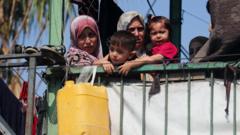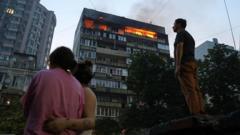Following significant drone warfare developments, the Pentagon is escalating its focus on upgrading drone defense systems, acknowledging newfound vulnerabilities revealed by recent military operations involving adversaries.
Pentagon Enhances Drone Defense Amid Evolving Threat Landscape

Pentagon Enhances Drone Defense Amid Evolving Threat Landscape
The U.S. military aims to bolster defenses against drone threats showcased during recent conflicts involving Israel and Ukraine.
The Pentagon has ramped up efforts to strengthen drone defenses at overseas military bases over the past 18 months, particularly after a tragic incident last year when three Army reservists lost their lives in a militia attack on a base in Jordan. Recent global conflicts have shed light on a wider range of potential threats, urging the U.S. defense apparatus to take proactive measures.
Notably, Israel and Ukraine have both employed drones in innovative and covert ways, targeting adversaries and breaching secure territories, thus highlighting vulnerabilities for the U.S. military not only abroad but potentially at home as well. The Israeli intelligence services have conducted operations striking targets deep inside Iran, while Ukraine's Operation Spider’s Web effectively knocked out critical Russian strategic bombers using drones launched from within Russian territory.
In response to these developments, American defense contractors are advocating for advanced technologies capable of intercepting drone threats more effectively. There's rising optimism that the billions anticipated for the Pentagon's missile defense initiative, known as the Golden Dome program, may also be channeled towards enhancing drone defensive capabilities.
Emerging technologies being explored do not merely focus on intercepting individual drones but involve innovative techniques like directed energy systems, including high-powered microwaves, designed to counteract large swarms of drones simultaneously. The military has initiated multiple successful tests of these microwave systems in diverse regions, laying the groundwork for a significant investment in drone defense strategies moving forward.























